
|   |

|   |
 e-mail: ukb7@rediffmail.com Fluent, fragrant, flamboyant Photos courtesy: Bappa Sen September 22, 2018 Living in Delhi, one comes across a very large number of highly esteemed Indian artists, including those from the performing arts of dance, having made the capital their centre of activities, for residence as well as performance. This seems to happen primarily for two reasons. First, the capital remains an assumed source of patronage from various quarters. And second, one gets to witness -- and thereby get intellectually stimulated -- by the visiting foreign artists, who always touch the capital in order to count "having done" a country, much like any other foreign tourist. Living in a far away eastern metropolis however, one perceives that Kolkata is disadvantaged precisely on the same two scores. At the beginning of a well-organised, three-day Festival of Indian Classical Dance, presented on September 7-9 by Dover Lane Music Conference and Dover Lane Music Academy at the ICCR Kolkata, when the latter's regional director made an observation on the relative absence of artist quality as well as audience enthusiasm in the classical dance scene, it was immediately pointed out by the secretary of the venerable Dover Lane authorities -- who have been organising these festivals every year very much on quality criteria alone -- that out of nine eminent performers this year, as many as five are from this very city. It became an interesting exercise for this critic to examine both these points and counter-points. The three opening performers on the three evenings were from the generation next. Apart from their young age deserving of encouragement, they had won the top laurels in their respective fields at the annual dance contests held by the Dover Lane authorities. On the first evening, Rishav Kumar Poddar - studying under Gurus Devi Chanda and Abhay Pal, and a graduate student of Rabindra Bharati University -- presented Bharatanatyam, starting with a Tisra Ekam Alarippu, then switching over to the keertan Nadanam Adinar... in Vasanta raga, and concluding with an abhinaya, Usha Parinayam, with choreography by Rukmini Devi Arundale and music in raga Paras by Geeta Chandran. He had a good stage presence and his lines were neat, but his hastamudras and mukhabhinaya were direly in need of more grooming under senior gurus from the right quarters. 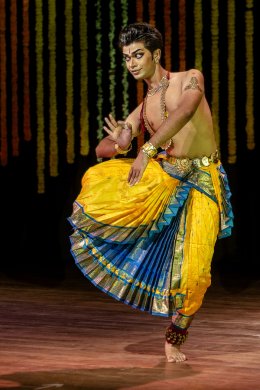 Rishav Kumar Poddar 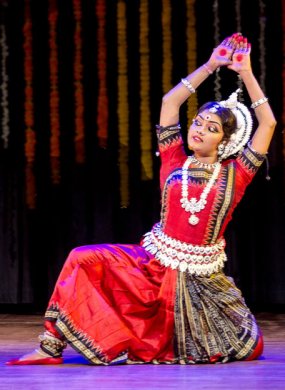 Meghna Das 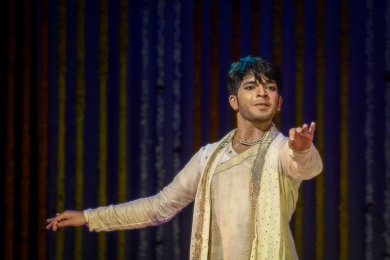 Shubhadeep Sahu 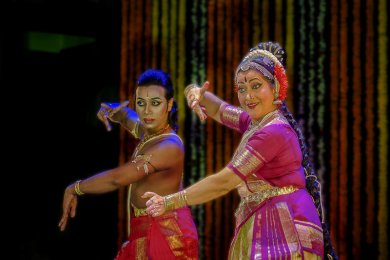 Dr. Madhuri Majumdar On the second evening, almost the same comments could be made for Meghna Das who opened the festival with her Odissi recital. Trained for 12 years under Guru Argha Chatterjee and an under-graduate student of Rabindra Bharati University, Meghna began with a Mangalacharan and a Bhoomi Pranam, followed by a Vishnu Vandana in ragas Jana Sanmohini and Mishra Khamaj, with choreography by Kelucharan Mohapatra and music by Pt. Bhubaneswar Mishra. She concluded with an elaborate Bageshri Pallavi in ektali, with music by Pt. Raghunath Panigrahi and choreography by Ratikant Mohapatra. Meghna was much better, but would also vastly gain by further honing of her skills. The opening performer on the third evening was Shubhadeep Sahu, who, in sharp contrast, was quite a finished performer. Trained well from the age of 10 by Guru Sandeep Mullick, and exposed to workshops by Pt. Birju Maharaj and others, he began with a Shiva Vandana, Om Namah Shivae... by Shankaracharya. He next presented traditional Kathak in Teentaal, demonstrating Upaj, Thaat, Tehai, Toda, Parmelu, Padhant, Chakradhar with deft Layakari. He then executed an astounding 108-round Chakkar (36, 36 and 36), seldom attempted by other dancers. He concluded with abhinaya, Mere suno Nath jaise sabko dukh haro..., with some more footwork. Among accomplished artists from this city, the first evening featured 'Kuchipudi Kalamadhuri' led by the noted exponent Dr. Madhuri Majumdar who has been performing and teaching Kuchipudi for last 35 years. A student of the legendary guru Vempati Chinna Satyam and a teacher at Rabindra Bharati University - where she did all her under graduate, post graduate and doctoral studies -- Madhuri began with a Gaja Vandana in raga Sri Ranjini and adi tala, with choreography by Vempati Chinna Satyam. Next came a tribute to Murugan (Kartikeya) with six heads dominating six human vices -- with choreography by seven dancers. The traditional Kuchipudi Tarangam -- with brass plates -- followed with five dancers in ragamalika and talamalika. The concluding Dashavatara was executed by six dancers also in ragamalika and adi talam. Unfortunately, Madhuri's entire oeuvre - including her own participation - seemed somewhat lacking in the spark of creativity. The last performance group from Kolkata was Anjika Centre of Manipuri Dance which performed Mani Chintani, conducted by the renowned dancer Priti Patel and led by S. Karuna Devi. The latter is a holder of Bismillah Khan Yuva Puraskar and excelled in a solo Dashavatar choreographed by Guru M. Amobi Singh. Next came a vigorous Dholak Cholam by K. Ratan Singh performed during Holi, followed by a sparkling sequence of the marital art of Thang Ta, spear and shield, sword and shield, and two swords by Th. Imocha Singh, Th. Jinan Singh, N. Nongshalen Singh and B. Pravin Sharma. The penultimate item was a virile Pung Cholam by K. Ratan Singh, which is a prologue to Rasleela. The finale was a scintillating Rasleela with five dancers - presenting S. Karuna Devi as Krishna and four other female dancers as Radha and Gopis - performed as Vasanta Ras on full moon night. There was powerful vocal support by W. Surajkumar all through. On the whole, Mani Chintani was an excellent showcase of Manipuri traditions, but not really Manipuri dance in its myriad shades which Priti presents usually with such panache. 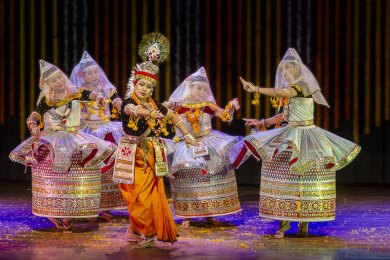 Anjika Centre of Manipuri Dance 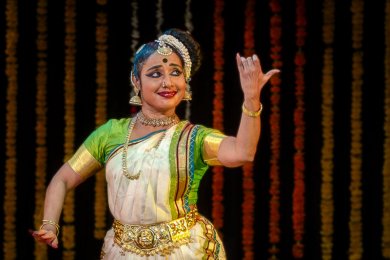 Dr. Neena Prasad 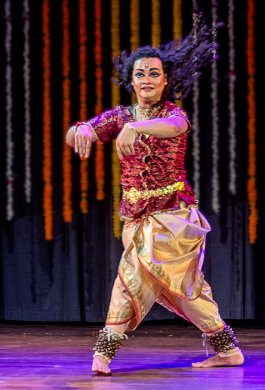 Vishal Krishna 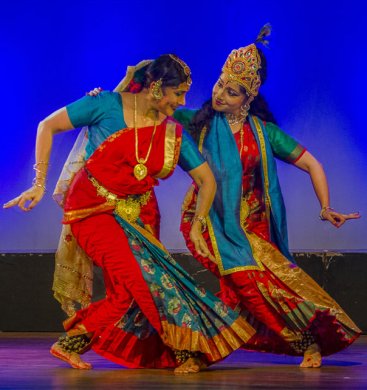 Vyjayanthi Kashi & Prateeksha Kashi Coming to four outstation performers, one must admit that the Dover Lane authorities did an impeccable selection of artists. On the second evening, both Dr. Neena Prasad and Vishal Krishna presented their artistic oeuvres. Neena had undergone rigorous training in all the four south Indian classical dance forms under the best of gurus and is now among the foremost exponents of Mohiniyattam in the country. Neena began her recital with Chollukattu in the sonorous raga Hamsadhwani and followed it up with a Swati Thirunal kriti in raga Hamsanandi and adi talam, depicting Shiva in Chidambaram's Chitrasabha, with the lord's third eye signifying 'Om'. Her third item, with the lilting lyric, Kandarpavijeta Mohini suravinodini...in raga Shuddha Dhanasree and mishra chapu taal composed by Kalamandalam Sugandhi was a pada varnam, extolling the melodious song in her lasya dominated exposition, yet so different from the gharanas of Bharati Shivaji and Dr Kanak Rele. She ended with a thillana set in the melodious raga Tilang and rupaka talam. Neena's superb performance was no less due to the outstanding vocal support by Changanasseri Madhavan Nampoothiri, who had composed the entire music for chollukattu, pada varnam and thillana for the evening. Chandra Kumar on mridangam and Syam Kalyan on violin provided adequate support. Vishal Krishna, born in 1991, has been something of a child phenomenon in Kathak dance, especially in the Banaras gharana. Having been trained by his grandmother, the legendary Sitara Devi, he has also been a torch-bearer of Gopi Krishna's heritage. Seen in indifferent health in Kolkata, Vishal took a dramatic entry with Ganesha Vandana. He then settled down to Paramparik Teentaal, showing his prowess in Layakari in Bandish, Tukra, a Gopi Krishna composition, Tehai, Chakradhar, a Sukhdev Maharaj composition, Chakkar, Gat Bhav, Gat Nikas, and ended with Ghunghat of three kinds. Next, he performed abhinaya to a bandish, Diwana ki ye shyam kya jadu dala... in Dadra. Switching over to Padhant, Tatkar and Layakari in footwork, he undertook a novelty for Kathak, dance on a brass plate (a la Kuchipudi) and executed complex rhythms. His fluidity of movements, quick-silver pauses and gaits, leaps into the air and advances on the floor while squatting, left the viewers mesmerised. Vyjayanthi Kashi has had an impressive career in Kuchipudi spanning an impressive array of performances, choreography, teaching, acting, research and organising dance events. Having had her grooming in Kuchipudi Yakshagana, solo Kuchipudi and temple ritual dances from the great gurus, she has proved to be a dynamic force in her chosen field of Kuchipudi. Her daughter Prateeksha Kashi has not merely followed her mother's passion in dance, but also excelled in academics and has additionally won a Bismillah Khan Yuva Puraskar. The mother-daughter duo launched a splendorous Kuchipudi dramatic feature, Chitra Lohita (the Red Portrait) weaving a garland of tales and parables from Puranas to bring out how the vibrant colour "red" can evoke all the navarasas in humans. Danced against a colourful cyclorama, kept luminous in blazing red, the narrator also evoked a radiant red sky - turning around from sunset into sunrise to capture mother earth's beauty -- narrowing it down to the red powder offered to the benign deity in the daily worship at private homes. The rapid fire sequence of episodes - spanning eras and aeons - visualised the little Hanumana flying towards the fiery sun, mistaking it to be a fruit and Indra causing his face to swell and remain tinged in red for ever; a mature Hanumana tearing open his blood-soaked heart to reveal Rama dwelling therein for ever; the demon Hiranyakashipu disparaging Vishnu despite his pious son Prahlada's pleading to the contrary and being ripped apart into red fragments of flesh by the ferocious Narasimha, an incarnation of Vishnu; Radha's crimson cheeks and rosy-red lips as delightful objects of Krishna's love play; the demon Raktabeeja's droplets of blood creating scores of violent demons: then challenged and killed by the malevolent goddess who licked away each blood drop; the mighty bird Jatayu's bleeding body unable to prevent demon Ravana's kidnap of the hapless Sita; finally, Bheema's quenching his thirst by killing Dusshasana and drinking his blood, and later smearing Draupadi's tresses with that blood, fulfilling her vow. The narrator proclaimed: "I am your red that redeems you into a world of my hue..." With B.N. Murthy's script and Uma Kumar's matching music, Vyjayanthi's choreography touched a new high. 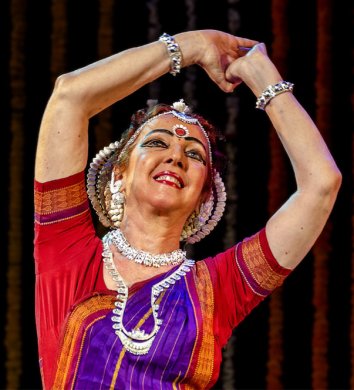 Dr. Ileana Citaristi Dr. Ileana Citaristi, a senior disciple of Guru Kelucharan Mohapatra, has brought to fruition many creative ideas and woven together diverse disciplines of dance, music, painting and literature. She had an early grounding in theatre under the thespian Grotowsky in Europe. She organises many major festivals in Odisha on a regular basis and teaches both Odissi and Chhau at her Art Vision Dance Academy. She opened the grand finale of the Kolkata festival with a Mangalacharan, depicting the usual Pushpanjali and Bhoomi Pranam, with her own choreography and music by Ghanashyam Panda. Next came her Art Vision group with five well-groomed dancers - Minati, Anindita, Mousumi, Upasana and Dibya - in a Bilawal Pallavi. Pure dance was well choreographed by Ileana in ektali with lyrical music interwoven within the fabric of myriad body movements. A soft blossoming forth of music by Laxmikant Palit saw beautiful rhythmic variations and cyclic patterns, ending in a crescendo. Sharanam (the Refuge) was an innovative solo by Ileana -- with multi-lingual music by Gopal Panda -- where she interpreted three mythical women from three different creeds, yet with an identical message: no sin was too big in front of God's merciful eyes. These were the three sex workers: Mary Magdalene of the Christian religion, Amrapali of the Buddhist Dharma and Pingala from the Hindu faith. Mary was saved from the public stone pelting by Jesus who asked the accusers: 'Who, among you, is without sin, should throw the first stone!' The rich courtesan Amrapali found refuge at the Buddha's feet who, regardless, accepted her as his disciple. Pingala realised the futility of lustful waiting for her rich client while Krishna, her real lover, resided in her heart. Another innovative group dance was Dasa Mahavidya, the ten manifestations of Devi, as quite a departure from the usual Dasavatar as Vishnu's incarnations. Accompanied by projection of images from authentic tantric sculptures, and based on music by Pt. Ramahari Das and Guru Banamali Maharana, Art Vision's four dancers presented the ten anthropomorphic forms: Kali 'the black goddess'; Tara 'who guides us across sansara'; Tripura Sundari 'the beauteous one in the three worlds'; Bhuvaneswari 'whose body is the world'; Chinnamasta 'the self-decapitated one'; Bhairavi 'the fierce one'; Dhumavati 'the one born out of smoke'; Bagalamukhi 'the paralyser'; Matangi 'the intoxicated dancer'; and Kamala 'the lotus seated goddess'. But the tour de force was yet to come, in the form of a serene, highly spiritual manifestation of Shiva by Ileana using Mayurbhanj Chhau style. In the dimly illumined ambience, the statuesque figure of the dancer assumed the matted-haired, ash-smeared, serpent-wielding, scantily-clad form of Shiva Nataraja, embodying and displaying the three universal qualities of Sattvah (excellence), Rajah (hyper activity) and Tamah (ignorance). The calm, meditative attitude transformed itself - ever so slowly - into an enraged, destructive mood which finally turned into playful, intoxicated madness. Using both restrained theatricality and controlled choreography, Ileana's dance left an impact that lingered in the spectators' mind for a long time to come.  Dr. Utpal K Banerjee is a scholar-commentator on performing arts over last four decades. He has authored 23 books on Indian art and culture, and 10 on Tagore studies. He served IGNCA as National Project Director, was a Tagore Research Scholar and is recipient of Padma Shri. Post your comments Please provide your name and email id when you use the Anonymous profile in the blog to post a comment. All appropriate comments posted with name & email id in the blog will also be featured in the site. |